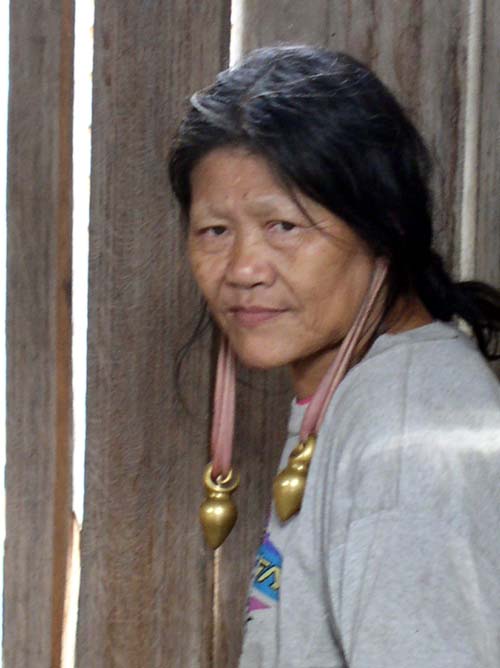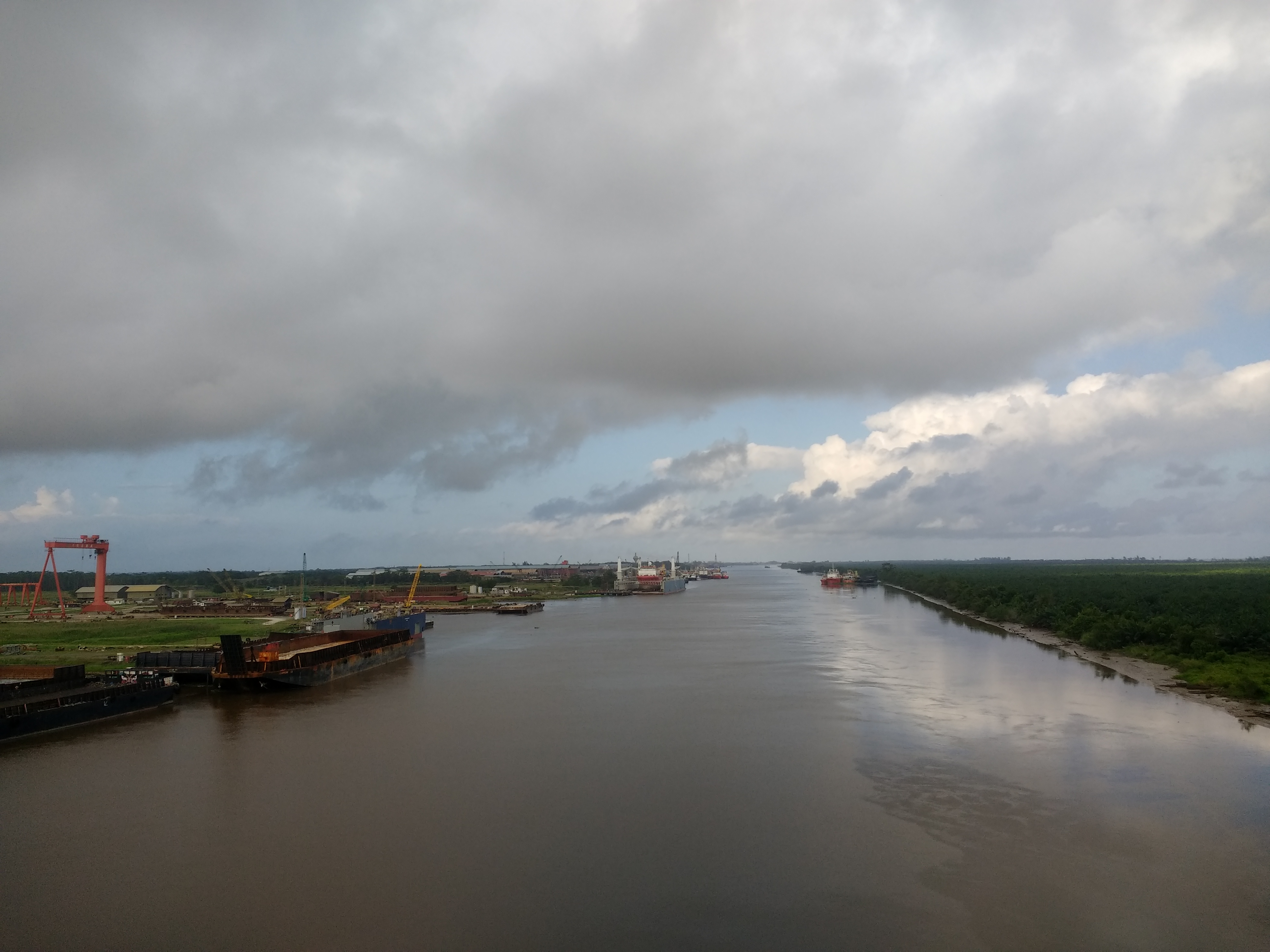|
Sabah–Sarawak Gas Pipeline
Sabah–Sarawak Gas Pipeline (SSGP) is a 500 kilometre Malaysian natural gas pipeline that linked Kimanis in Sabah to Bintulu in Sarawak. The pipeline is part of the Petronas development project of "Sabah–Sarawak Integrated Oil and Gas Project", and has start operating since early 2014. Due to the unstable geographic location of the pipeline with frequent soil movement and subsidence that is causing frequent gas leaks, the pipeline between Lawas to Bintulu is in the process of being fully decommissioned from 2025 until 2027. History The pipeline was constructed in 2011 with a total of RM4.6 billion (US$1 billion) been allocated to complete the project. Gas leak incidents (2014–2022) There have been four reported gas leaks along the line, two resulting explosions. On 11 June 2014, the pipeline located in between Lawas and Long Sukang in Sarawak exploded that caused the temporary shutdown of the line. No casualties were reported in the incident. On 10 January 2018, the ... [...More Info...] [...Related Items...] OR: [Wikipedia] [Google] [Baidu] |
Natural Gas
Natural gas (also fossil gas, methane gas, and gas) is a naturally occurring compound of gaseous hydrocarbons, primarily methane (95%), small amounts of higher alkanes, and traces of carbon dioxide and nitrogen, hydrogen sulfide and helium. Methane is a colorless and odorless gas, and, after carbon dioxide, is the second-greatest greenhouse gas that contributes to global climate change. Because natural gas is odorless, a commercial odorizer, such as Methanethiol (mercaptan brand), that smells of hydrogen sulfide (rotten eggs) is added to the gas for the ready detection of gas leaks. Natural gas is a fossil fuel that is formed when layers of organic matter (primarily marine microorganisms) are thermally decomposed under oxygen-free conditions, subjected to intense heat and pressure underground over millions of years. The energy that the decayed organisms originally obtained from the sun via photosynthesis is stored as chemical energy within the molecules of methane and other ... [...More Info...] [...Related Items...] OR: [Wikipedia] [Google] [Baidu] |
Penan People
The Penan are a nomadic indigenous people living in Sarawak and Brunei, although there is only one small community in Brunei; among those in Brunei half have been converted to Islam, even if only superficially. Penan are one of the last such peoples remaining as hunters and gatherers. The Penan are noted for their practice of 'molong' which means never taking more than necessary. Most Penan were nomadic hunter-gatherers until the post-World War II missionaries settled many of the Penan, mainly in the Ulu-Baram district but also in the Limbang district. They eat plants, which are also used as medicines, and animals and use the hides, skin, fur, and other parts for clothing and shelter. Demographics The Penan number around 16,000;Main_Penan_Settlements.html [...More Info...] [...Related Items...] OR: [Wikipedia] [Google] [Baidu] |
Buildings And Structures In Sabah
A building or edifice is an enclosed structure with a roof, walls and windows, usually standing permanently in one place, such as a house or factory. Buildings come in a variety of sizes, shapes, and functions, and have been adapted throughout history for numerous factors, from building materials available, to weather conditions, land prices, ground conditions, specific uses, prestige, and aesthetic reasons. To better understand the concept, see ''Nonbuilding structure'' for contrast. Buildings serve several societal needs – occupancy, primarily as shelter from weather, security, living space, privacy, to store belongings, and to comfortably live and work. A building as a shelter represents a physical separation of the human habitat (a place of comfort and safety) from the ''outside'' (a place that may be harsh and harmful at times). buildings have been objects or canvasses of much artistic expression. In recent years, interest in sustainable planning and building pract ... [...More Info...] [...Related Items...] OR: [Wikipedia] [Google] [Baidu] |
2014 Establishments In Malaysia
Fourteen or 14 may refer to: * 14 (number), the natural number following 13 and preceding 15 * one of the years 14 BC, AD 14, 1914, 2014 Music * 14th (band), a British electronic music duo * ''14'' (David Garrett album), 2013 *''14'', an unreleased album by Charli XCX * "14" (song), a 2007 song by Paula Cole from ''Courage'' * "Fourteen", a 2000 song by The Vandals from '' Look What I Almost Stepped In...'' Other uses * ''Fourteen'' (film), a 2019 American film directed by Dan Sallitt * ''Fourteen'' (play), a 1919 play by Alice Gerstenberg * ''Fourteen'' (manga), a 1990 manga series by Kazuo Umezu * ''14'' (novel), a 2013 science fiction novel by Peter Clines * '' The 14'', a 1973 British drama film directed by David Hemmings * Fourteen, West Virginia, United States, an unincorporated community * Lot Fourteen, redevelopment site in Adelaide, South Australia, previously occupied by the Royal Adelaide Hospital * "The Fourteen", a nickname for NASA Astronaut Group 3 * Fourte ... [...More Info...] [...Related Items...] OR: [Wikipedia] [Google] [Baidu] |
List Of Natural Gas Pipelines
This is a list of pipelines used to transport natural gas. Africa * Trans-Saharan gas pipeline (planned) * West African Gas Pipeline * Escravos–Lagos Pipeline System Asia * Altai gas pipeline (planned) * Arab Gas Pipeline * Pak Arab Pipeline Co. Ltd * Sui Southern Pipeline Ltd * Sui Northern Gas Pipelines Limited * Bukhara-Tashkent-Bishkek-Almaty pipeline * Central Asia-Center gas pipeline system * Central Asia-China gas pipeline * Dabhol-Bangalore Natural Gas Pipeline * Dolphin Gas Project * East West Gas Pipeline (India) * HVJ Gas Pipeline * Iran-Armenia Natural Gas Pipeline * Iran-Pakistan-India gas pipeline (under construction) * Tabriz–Ankara pipeline * Korpezhe-Kurt Kui Pipeline * Myanmar-Thailand Pipelines (3) * Peninsular Gas Pipeline * Sabah–Sarawak Gas Pipeline * Shaan-Jing pipeline * South Caucasus Pipeline (Baku-Tbilisi-Erzurum pipeline) * Trans Thailand Malaysian Gas Pipeline * Trans-Afghanistan Pipeline (planned) * Trans-Caspian Gas P ... [...More Info...] [...Related Items...] OR: [Wikipedia] [Google] [Baidu] |
Oil Well Control
Oil well control is the management of the dangerous effects caused by the unexpected release of formation fluid, such as natural gas and/or crude oil, upon surface equipment of oil or gas drilling rigs and escaping into the atmosphere. Technically, oil well control involves preventing the formation gas or fluid (hydrocarbons), usually referred to as kick, from entering into the wellbore during drilling or well interventions. Formation fluid can enter the wellbore if the pressure exerted by the column of drilling fluid is not great enough to overcome the pressure exerted by the fluids in the formation being drilled (pore pressure). Oil well control also includes monitoring a well for signs of impending influx of formation fluid into the wellbore during drilling and procedures, to stop the well from flowing when it happens by taking proper remedial actions. Failure to manage and control these pressure effects can cause serious equipment damage and injury, or loss of life. Impro ... [...More Info...] [...Related Items...] OR: [Wikipedia] [Google] [Baidu] |
Bintulu District
The Bintulu District is one of two districts of Bintulu Division in Sarawak, Malaysia. It has a total area of . Bintulu District has a sub-district, Sebauh. There are two towns in Bintulu District, namely Bintulu, which is the capital of both Bintulu District and Bintulu Division, and Sebauh. Demography The population of Bintulu District was estimated at 186,100 in 2008. Most of the Bintulu district's population is concentrated at Bintulu proper. Ethnics Bintulu is traditionally a home to Iban, Chinese, Melanau, Malay, Orang Ulu and Kedayan people. Most Ibans are scattered throughout rural areas of Bintulu, namely in Tatau and Sebauh. Melanau people (or Melanau Bintulu/Vaie people) are concentrated at the town areas in Bintulu and rural communal areas, namely at Bintulu town, Sebauh, Pandan and Labang. Many Malay people are not originally from Bintulu, however, intermarriage with locals, especially Melanau people, has made Malay as one of the major ethnic groups in Bintul ... [...More Info...] [...Related Items...] OR: [Wikipedia] [Google] [Baidu] |
Miri District
Miri District is an administrative district in Miri Division, Sarawak, Malaysia covering a total area of 4707 km2. The Miri District can be divided into Miri, Malaysia, Miri City (997.43 km2), Sibuti sub-district (842.47 km2), and Niah sub-district (2887.21 km2). They are governed by Miri District Office located in Miri City, Sibuti sub-district office, and Niah sub-district office. The Miri City is administered by Miri City Council (MCC). Meanwhile, Niah and Sibuti sub-district falls under the jurisdiction of Subis District Council headquartered at Bekenu. Federal Parliament and State Assembly Seats List of Miri district representatives in the Federal Parliament (Dewan Rakyat) List of Miri district representatives in the State Legislative Assembly of Sarawak State Legislative Assembly, Sarawak Demography There has been a growth of Miri District population of 3.5% from 1991 to 2000. Meanwhile, from 2000 to 2010, there is a population growth of 2.8 ... [...More Info...] [...Related Items...] OR: [Wikipedia] [Google] [Baidu] |
Limbang District
The Limbang District is one of the two districts of Limbang Division, Malaysia. It has a total area of 3,978.10 square kilometres. The major town is Limbang. It has one sub-district, which is Nanga Medamit Sub-District. It borders Brunei Darussalam to the west and east, Lawas District to the southeast and Miri District at the south and southwest. Due to being squeezed in between Brunei at its north and coastal areas, Limbang is accessible by road only by going through immigration posts. History The area was annexed by Charles Anthoni Johnson Brooke, the second Rajah of Sarawak in 1890 from Brunei to become the fifth division of Sarawak. The annexation was strongly disputed by Brunei. The de facto boundary ran along the watershed between the Brunei River and Limbang River basins on the western side of the district, and along the length of the Pandaruan River on the eastern side. Boundary agreements have delineated a stretch of the western border and the Pandaruan Ri ... [...More Info...] [...Related Items...] OR: [Wikipedia] [Google] [Baidu] |
Baram River
The Baram River () is a river in Sarawak on the island of Borneo. The river originates in the Kelabit Highlands, a watershed demarcated by the Iran Mountains of East Kalimantan, which form a natural border with Sarawak. Geography The Baram river basin, an area of some , has been part of Sarawak since it was ceded to the White Rajah of Sarawak by the then sultan of Brunei in 1882, for a perpetual annual payment of 6,000 dollars. The river flows westwards through tropical rainfores (Köppen climate classification ''Af'' type) to the South China Sea. The Baram catchment receives around 3,800 mm of rainfall per year. The Baram River terminates in a delta, which is subdivided into two units: East Barma Delta of Middle-Late Miocene age and West Baram Delta of Late Miocene-Quaternary age. The western unit is composed of mudstones enriched in organic components ( total organic carbon content is more than 1.0 wt.%) which constitute substantial oil and gas reserves. The river is ... [...More Info...] [...Related Items...] OR: [Wikipedia] [Google] [Baidu] |
Limbang Division
Limbang Division () is one of the twelve administrative divisions of Sarawak, Malaysia. It has a total area of 7,788.50 square kilometres, and is the fourth largest division after Kapit Division, Miri Division and Bintulu Division. Limbang Division consists of two districts which are Limbang District and Lawas District, which in turn are divided as sub-districts in Limbang ( Nanga Medamit Sub-District) and two sub-districts in Lawas ( Sundar Sub-District and Trusan Sub-District). Long Semadoh and Ba’kelalan are rural settlements in the southern part of Lawas district. Two major towns in Limbang are Limbang and Lawas. There are also few smaller towns such as Sundar, Trusan, Merapok and Tedungan. Geography Limbang Division splits Brunei Darussalam into two; West Brunei to the west and Temburong District in the middle of Limbang and Lawas districts. Limbang is located between West Brunei and Temburong, while Lawas is located between Temburong and the Malaysian state of ... [...More Info...] [...Related Items...] OR: [Wikipedia] [Google] [Baidu] |



